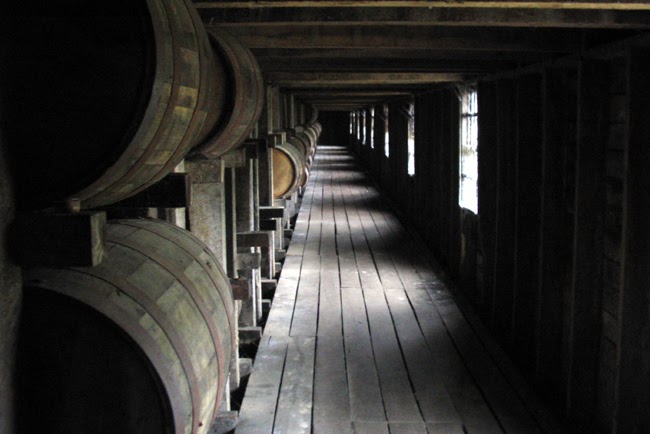
 |
| A maturation warehouse at Barton 1792 Distillery, Nelson County, Kentucky. |
“Bitter bourbon battle pits Buffalo Trace against Franklin County residents over new warehouse,” screams the headline in today’s Herald-Leader, which typically has the state’s best bourbon industry coverage.
The news business is brutal right now so I won’t fault the sensationalized headline. These ‘bitter bourbon battles’ have become commonplace in the last 20 years. Kentucky’s signature industry is doing quite well right now, in case you haven’t noticed. More people buying more Kentucky whiskey means Kentucky whiskey-makers must make more whiskey, in Kentucky. Because of American whiskey’s marvelous, unavoidable aging process, increasing sales means more maturation warehouses must be built and filled.
I apologize if this seems too elementary.
Because a maturation warehouse, being mostly wood and high-proof alcohol, is kind of flammable, you don’t want them too close to people. The industry’s safety record is very good, but still.
In addition to fire risk, neighbors worry about Baudoinia compniacensis, the ‘whiskey fungus’ that is a harmless nuisance but easy to scare people with. The scare-mongers will call it ‘little studied’ or ‘mysterious’ even though it was identified and described about 150 years ago. It was first analyzed by a pharmacist in Cognac named Baudoin, hence the name. It has been observed everywhere distilled spirits are aged in wood all over the world.
Yes, it’s weird? It seems to appear and grow only where there is a sufficient concentration of ethanol vapor in the atmosphere. Yes, it’s unexpected. Why is there suddenly black mold growing on my garage? Yes, it’s ugly. Yes, it washes off, but it grows back.
It is also true that many, many people–millions–have lived their whole lives around it and never gotten sick. There is literally zero evidence, after 150 years, that it poses any kind of health risk to anyone or anything.
Since Baudoin, interest in studying it comes and goes. Every so often there is a new study, which benefits from the latest technology. There isn’t more research because Baudoinia isn’t very interesting. It doesn’t do anything except make surfaces where it grows look dirty.
Believe it or not, whiskey companies want to be good neighbors. They don’t want any trouble if they can avoid it. The only practical way to contain the fungus, so it doesn’t dirty-up people’s garage doors, is to build new maturation facilities on large parcels of land, typically 300 acres or more. Provide that kind of buffer around the warehouses and little if any of the fungus will make it past the perimeter. Building these facilities on large tracts in rural areas is the solution, not the problem.
The maturation facility itself takes only a tiny fraction of the parcel out of agricultural production. It can continue to be cropland or pasturage or even woodland.
Traffic is the other typical ‘concern’ expressed by members of the affected community. Bear in mind, the whole idea of a maturation facility is that once a barrel is in the racks, it doesn’t budge until it is time to put it in a bottle, four to ten years later. That simple fact means the number of barrels going in or coming out of the facility on any given day will be very small. A distillery, especially a distillery with a visitor center, then you’re talking traffic. A maturation facility? Very little impact on traffic.
Most of these objections are the normal ‘not-in-my-backyard’ reaction businesses and governments face with just every development or re-development proposal, and that is not entirely a bad thing. People should see how the sausage is made. That should encourage them to learn more about sausage-making and maybe even make some sausage themselves. In a healthy democracy, the more the merrier.
You would think that with as long as Kentucky has been aging whiskey, about 150 years, they would have worked out some of these land use issues, ideally with a statewide standard. As recently as 2016 the next county over, Woodford, was arguing about whether or not whiskey maturation warehouses are an ‘agricultural use.’
The Herald-Leader story is well-reported. It shows that the opponents are mostly using procedural and legalistic tactics to delay approval, or perhaps to encourage the developer to go elsewhere where there will be less trouble, except there is no such place.
